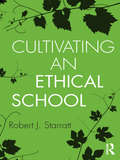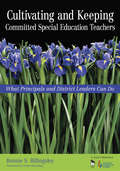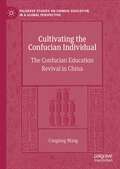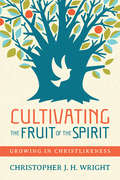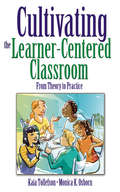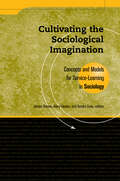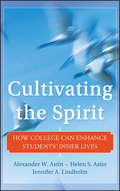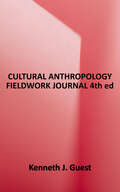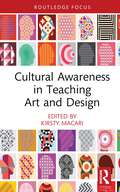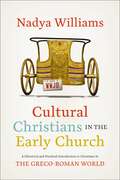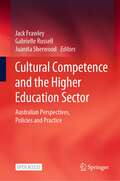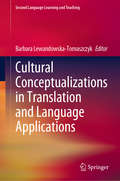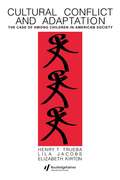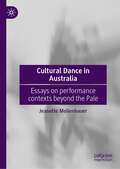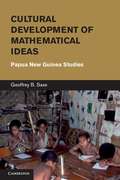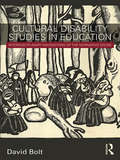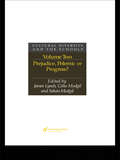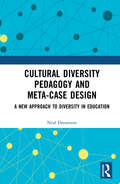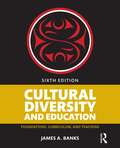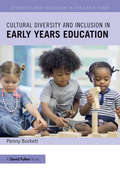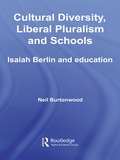- Table View
- List View
Cultivating an Ethical School
by Robert J. StarrattOften the school is left as an institution seemingly ethically neutral, leaving untouched questions about whether the school itself is a site of injustice toward both educators and children. Springing from his well-known Building an Ethical School, Robert J. Starratt now looks more closely at the educational leader’s responsibility to ensure that the whole fabric of the educational process reflects an ethical philosophy of education. Starratt argues that the work of educating young people is by its very nature an ethical work as well as an intellectual work, and that this work inescapably engages educators and their pupils with an academic curriculum, a social curriculum, and a civic curriculum. Cultivating an Ethical School lays a foundation for educators seeking to cultivate a comprehensive ethical educating environment. The second half of the book then takes up the more specific perspectives on teaching and learning that constitute the heart of cultivating an ethical school. Starratt provides examples of how an ethical school can expose students to a variety of perspectives on the challenges they will be called upon to face in the worlds of culture, nature, and society. This valuable book shows leaders and educators the importance of organizing a curriculum and a pedagogy that simultaneously respect and cultivate the intellectual, personal, and social qualities of being human.
Cultivating and Keeping Committed Special Education Teachers: What Principals and District Leaders Can Do
by Bonnie S. BillingsleyBillingsley highlights the problems that drive many special educators out of teaching and outlines practical recommendations that leaders can use to increase retention.
Cultivating diversity and inclusion: using global and multicultural children's literature in grades K-5, Second Edition
by Paula Saine"Cultivating Diversity and Inclusion: Using Global and Multicultural Children's Literature in Grades K-5 offers children's books from across the world that engages students with cultural language experiences and provides ways to incorporate apps and social media activities in the classroom"--Provided by publisher.
Cultivating the Arts in Education and Therapy
by Malcolm RossThe constituency for education and therapy in the arts is rapidly expanding beyond the conventional school and clinical settings to include the wider community. In Cultivating the Arts in Education and Therapy, Malcolm Ross integrates traditional Chinese Five Element Theory, also known as The Five Phases of Change, with contemporary Western psychological and cultural studies, to form a new Syncretic Model of creative artistic practice. The Syncretic Model is explored and validated through an analysis of interviews with practising, successful artists, and in a comprehensive review of the latest neuro-scientific research into human consciousness and emotion. The book addresses the well-documented difficulties experienced by arts teachers and therapists intervening in, supporting and evaluating the creative development of individual students and clients. This groundbreaking text repositions the arts as central to the effective initiation and management of change in contemporary society. Besides being of wide general interest, it will have particular relevance for practising and trainee arts teachers, arts therapists and community artists. With the demand for their services growing and pressure to demonstrate effectiveness mounting, the arts community is looking to build bridges between the different arts, and between arts education and therapy across national boundaries. This book offers a fresh, coherent, and challenging framework for a revitalized reflective practice from an experienced authority in the field.
Cultivating the Confucian Individual: The Confucian Education Revival in China (Palgrave Studies on Chinese Education in a Global Perspective)
by Canglong WangThis book explores the complexities of cultivating ‘Confucian individuals’ through classics study in contemporary China by drawing on the individualization thesis and its implications for the Confucian education revival. Based on ethnographic fieldwork conducted at a Confucian classical school, three topics are investigated: parents’ narratives and actions related to ‘dis-embedding’ their children from mainstream state education and transferring them to Confucian education as an alternative; the specific discourses and practices of teaching and learning the classics in everyday school life, guided by the aim of training students to become autonomous learners; and the institutional and subjective dilemmas that arise when parents and students seek to ‘re-embed’ themselves in either the state education system or further Confucian studies at an advanced academy for the next stage of education. The research presented in this book contributes to understanding the hidden dynamics of individualization in the Confucian education revival and the intricacies of subject-making through Confucian teaching and learning in the socialist state of China.
Cultivating the Fruit of the Spirit: Growing in Christlikeness
by Christopher J. H. WrightHow should Christians live? On the one hand, some very legalistic Christians stress the importance of keeping all the rules—that you must do this and never do that if you want to prove you are really a Christian. On the other hand, there are those who reject the whole idea of rules or traditions in the church and see the point of the Christian faith as setting us free from the institutionalized religious burden. But Paul addresses these two competing views by showing us a far better way—a truly Christian way to live our lives. It is the way of the Spirit of God given to us through Christ: "Walk by the Spirit . . . led by the Spirit . . . live by the Spirit . . . keep in step with the Spirit." That is the heart and soul of Christian living. It is the center and secret of what it means to be a person who belongs to Christ. Pastor and scholar Christopher Wright invites us to live a life in step with the Spirit by cultivating the fruit of the Spirit: love, joy, peace, patience, kindness, goodness, faithfulness, gentleness, and self-control. These nine chapters, each addressing a different fruit, each conclude with questions for contemplation or discussion. Feed on the Word of God, grow in Christlikeness, and live a fruitful life.
Cultivating the Learner-Centered Classroom: From Theory to Practice
by Kaia A. Tollefson Monica K. OsbornDrawing from progressive educational thought, this guide helps teachers translate theory into classroom practice in seven crucial areas, including developing communities of learners, planning instruction, and more.
Cultivating the Sociological Imagination: Concepts and Models for Service Learning in Sociology
by James Ostrow Garry Hesser Sandra EnosThe editors and authors of this book, seventh in the Service-Learning in the Disciplines Series, bring their own sociological wisdom and imagination to demonstrate how service-learning can effectively be used in the sociology curricula and in class exercises. Discussions in the introduction and chapters, along with appended syllabi, provide ways in which such programs can be adopted in undergraduate sociology courses.
Cultivating the Spirit
by Astin Alexander W. Helen S. Lindholm Jennifer A.This book is predicated on the belief that the spiritual development of college students has been largely ignored in our colleges and universities, despite the importance of spiritual matters to young people in their quest to lead integrated lives. Thus, while academics are understandably proud of their "outer" accomplishments in the fields of science, medicine, technology, and commerce, colleges and universities have increasingly come to neglect the student's "inner" development--the sphere of values and beliefs, emotional maturity, spirituality, and self-understanding. The book defines "spiritual development" very broadly: how students make meaning of their education and their lives, how they develop a sense of purpose, the value and belief dilemmas that they experience, as well as the role of religion, the sacred, and the mystical in their lives. Each student, of course, will view his or her spirituality in a unique way. For many, traditional religious beliefs and practices may form the core of their spirituality; for others such beliefs and practices may play little or no part. While two-thirds of the students in the study express a strong interest in spiritual matters, well over half report that their professors never encourage discussions of religious/spiritual matters, and about the same proportion report that professors never provide opportunities to discuss the purpose and meaning of life. By raising public awareness of the important role that spirituality plays in student learning and development, by alerting academic administrators, faculty, and curriculum committees to the importance of spiritual development, and by identifying possible strategies for enhancing that development, the book will encourage institutions to give greater priority to these spiritual aspects of students' educational and personal development.
Cultural Action for Freedom (HER Reprint Series)
by Paulo FreireIn this volume, we have chosen to highlight the importance of education to human rights by reprinting two articles written by Paulo Freire (1921-1997) in 1970 for the Harvard Educational Review.
Cultural Anthropology Fieldwork Journal
by Kenneth J. GuestEthnographic fieldwork is one of the most fundamental tools for anthropological study. The step-by-step exercises in Ken Guest's Cultural Anthropology Fieldwork Journal encourage students to apply the concepts they are learning in class and observe, question, and generate their data about the places, relationships, and networks that they may take for granted in everyday life: from friendships, family dynamics, and consumption habits to classrooms, places of worship, smartphones, and their own homes.
Cultural Awareness in Teaching Art and Design (Routledge Focus on Design Pedagogy)
by Kirsty MacariCultural Awareness in Teaching Art and Design addresses an emerging area of development in contemporary pedagogy, the fostering of cultural awareness and sensitivity in the designers of tomorrow.By offering new and unique examples of how to better educate students around issues of cultural awareness, this book presents teaching methodologies that ultimately facilitate students in becoming better, and more inclusive, art and design professionals. Today, the role of education in the addressing of social and cultural issues is increasingly seen as central to pedagogical methodologies. Through engaged teaching, experiential learning, socially orientated pedagogy or any other definition, the idea that students can and should be exposed to, and deal with, issues of importance to various stakeholders is increasingly seen as central to the teaching and learning experience – whether it be in relation to local communities, national economies, regional cultural identities or more. This is explored in a series of innovative, cross-disciplinary case studies in art and design teaching, with authors approaching questions of cultural awareness and engagement through the lenses of art history, product design, communication design, film, architecture and interior design. In presenting their pedagogical methodologies and case studies, the authors in this text offer a unique cross-disciplinary design perspective that captures the cultural and social concerns of several regions of the world: Europe, North America, Asia and Africa and the Middle East.This book will be essential reading for art and design educators and students interested in developing and applying models of cultural awareness and engagement in the classroom and studio.
Cultural Capital and Parental Involvement: A Comparison of Students’ Music Participation between Beijing and Hong Kong
by Siu-hang KongThis book uses Pierre Bourdieu’s cultural capital model as a theoretical framework for exploring how students in Beijing and Hong Kong perceive parental influences—their parents’ cultural capital and support—on their participation in musical activities. By studying students’ perceptions of their parents’ cultural capital and support for their musical activities, this book revisits the applicability of Bourdieu’s cultural capital model in the contemporary Chinese context and reveals how inequality in terms of parental cultural capital governs parents’ support and influences the intergenerational transmission of cultural capital, which in turn contributes to inequality in terms of students’ cultural capital.
Cultural Christians in the Early Church: A Historical and Practical Introduction to Christians in the Greco-Roman World
by Nadya WilliamsIn the middle of the third century CE, one North African bishop wrote a treatise for the women of his church, exhorting them to resist such culturally normalized yet immodest behaviors in their cosmopolitan Roman city as mixed public bathing in the nude, and wearing excessive amounts of jewelry and makeup. The treatise appears even more striking, once we realize that the scandalous virgins to whom it was addressed were single women who had dedicated their virginity to Christ.Stories like this one challenge the general assumption among Christians today that the earliest Christians were zealous converts who were much more counterculturally devoted to their faith than typical church-goers today. Too often Christians today think of cultural Christianity as a modern concept, and one most likely to occur in areas where Christianity is the majority culture, such as the American "Bible Belt." The story that this book presents, refutes both of these assumptions.Cultural Christians in the Early Church, which aims to be both historical and practical, argues that cultural Christians were the rule, rather than the exception, in the early church. Using different categories of sins as its organizing principle, the book considers the challenge of culture to the earliest converts to Christianity, as they struggled to live on mission in the Greco-Roman cultural milieu of the Roman Empire. These believers blurred and pushed the boundaries of what it meant to be a saint or sinner from the first to the fifth centuries CE, and their stories provide the opportunity to get to know the regular people in the early churches. At the same time, their stories provide a fresh perspective for considering the difficult timeless questions that stubbornly persist in our own world and churches: when is it a sin to eat or not eat a particular food? Are women inherently more sinful than men? And why is Christian nationalism a problem and, at times, a sin? Ultimately, recognizing that cultural sins were always a part of the story of the church and its people is a message that is both a source of comfort and a call to action in our pursuit of sanctification today.
Cultural Competence and the Higher Education Sector: Australian Perspectives, Policies and Practice
by Jack Frawley Gabrielle Russell Juanita SherwoodThis open access book explores cultural competence in the higher education sector from multi-disciplinary and inter-disciplinary perspectives. It addresses cultural competence in terms of leadership and the role of the higher education sector in cultural competence policy and practice. Drawing on lessons learned, current research and emerging evidence, the book examines various innovative approaches and strategies that incorporate Indigenous knowledge and practices into the development and implementation of cultural competence, and considers the most effective approaches for supporting cultural competence in the higher education sector. This book will appeal to researchers, scholars, policy-makers, practitioners and general readers interested in cultural competence policy and practice.
Cultural Conceptualizations in Translation and Language Applications (Second Language Learning and Teaching)
by Barbara Lewandowska-TomaszczykThe book comprises a selection of 14 papers concerning the general theme of cultural conceptualizations in communication and translation, as well as in various applications of language.Ten papers in first part Translation and Culture cover the topics of a cognitive approach to conceptualizations of Source Language – versus Target Language – texts in translation, derived from general language, media texts, and literature.The second part Applied Cultural Models comprises four papers discussing cultural conceptualizations of language in the educational context, particularly of Foreign Language Teaching, in online communication and communication in deaf communities.
Cultural Conflict & Adaptation: The Case Of Hmong Children In American Society (Routledge Library Editions: Immigration And Migration Ser. #7)
by Henry T. Trueba Lila Jacobs Elizabeth KirtonFirst published in 1990. Routledge is an imprint of Taylor & Francis, an informa company.
Cultural Dance in Australia: Essays on performance contexts beyond the Pale
by Jeanette MollenhauerThis book draws on theories of aesthetics, post-colonialism, multiculturalism and transnationalism to explore salient aspects of perpetuating traditional dance customs in diaspora. It is the first book to present a broad-ranging analysis of cultural dance in Australia. Topics include adaptation of dance customs within a post-migration context, multicultural festivals, prominent performers, historiographies and archives, and the relative positionings of cultural and Western theatrical dance genres. The book offers a decolonized appraisal of dance in Australia, critiquing past and present praxes and offering suggestions for the future. Overall, it underscores the highly variegated nature of the Australian dance landscape and advocates for greater recognition of amateur community dance practices. Cultural Dance in Australia makes a substantial contribution to the catalogue of work about immigrants and cultural dance styles that continue to be preserved in Australia. This book will be of interest to scholars of dance, performance studies, migration studies and transnationalism.
Cultural Development of Mathematical Ideas
by Geoffrey B. Saxe Indigo EsmondeDrawing upon field studies conducted in 1978, 1980, and 2001 with the Oksapmin, a remote Papua New Guinea group, Geoffrey B. Saxe traces the emergence of new forms of numerical representations and ideas in the social history of the community. In traditional life, the Oksapmin used a counting system that makes use of twenty-seven parts of the body; there is no evidence that the group used arithmetic in prehistory. As practices of economic exchange and schooling have shifted, children and adults unwittingly reproduced and altered the system in order to solve new kinds of numerical and arithmetical problems, a process that has led to new forms of collective representations in the community. While Dr. Saxe's focus is on the Oksapmin, the insights and general framework he provides are useful for understanding shifting representational forms and emerging cognitive functions in any human community.
Cultural Disability Studies in Education: Interdisciplinary Navigations of the Normative Divide (Routledge Advances in Disability Studies)
by David BoltOver the last few decades disability studies has emerged not only as a discipline in itself but also as a catalyst for cultural disability studies and Disability Studies in Education. In this book the three areas become united in a new field that recognises education as a discourse between tutors and students who explore representations of disability on the levels of everything from academic disciplines and knowledge to language and theory; from received understandings and social attitudes to narrative and characterisation. Moving from late nineteenth to early twenty-first-century representations, this book combines disability studies with aesthetics, film studies, Holocaust studies, gender studies, happiness studies, popular music studies, humour studies, and media studies. In so doing it encourages discussion around representations of disability in drama, novels, films, autobiography, short stories, music videos, sitcoms, and advertising campaigns. Discussions are underpinned by the tripartite model of disability and so disrupt one-dimensional representations. Cultural Disability Studies in Education encourages educators and students to engage with disability as an isolating, hurtful, and joyful experience that merits multiple levels of representation and offers true potential for a non-normative social aesthetic. It will be required reading for all scholars and students of disability studies, cultural disability studies, Disability Studies in Education, sociology, and cultural studies.
Cultural Diversity And The Schools: Volume 2: Prejudice, Polemic Or Progress? (Cultural Diversity And The Schools Ser. #Vol. 3)
by James Lynch Sohan Modgil Celia ModgilFirst published in 1992. Routledge is an imprint of Taylor & Francis, an informa company.
Cultural Diversity Pedagogy and Meta-Case Design: A New Approach to Diversity in Education
by Neal DreamsonResponding to the growing need for educators to have a deeper understanding of cultural diversity, this book provides a theoretically-rich and empirically-sound analysis of diversity education, to develop a new cultural diversity pedagogy. The author deconstructs and navigates the complex field of diversity education, arguing for a more socially engaged approach, in which educators and researchers develop their perspectives on cultural diversity by examining their own assumptions, values, and beliefs. This is explored through a series of 10 case studies based in primary school settings demonstrating that teaching and learning environments are crucial to the success of cultural diversity.
Cultural Diversity and Education: Foundations, Curriculum, and Teaching
by James A. BanksNow available in paperback, the sixth edition of this definitive text provides students a strong background in the conceptual, theoretical, and philosophical issues in multicultural education from a leading authority and scholarly leader of the field---James A. Banks. In the opening chapter author Banks presents his well-known and widely used concept of Dimensions of Multicultural Education to help build an understanding of how the various components of multicultural education are interrelated. He then provides an overview on preparing students to function as effective citizens in a global world; discusses the dimensions, history, and goals of multicultural education; presents the conceptual, philosophical, and research issues related to education and diversity; examines the issues involved in curriculum and teaching; looks at gender equity, disability, giftedness, and language diversity; and focuses on intergroup relations and principles for teaching and learning. This new edition incorporates new concepts, theories, research, and developments in the field of multicultural education and features: A new Chapter 5, "Increasing Student Academic Achievement: Paradigms and Explanations" provides important explanations for the achievement gap and suggests ways that educators can work to close it. A new Chapter 7, "Researching Race, Culture, and Difference," explains the unique characteristics of multicultural research and how it differs from mainstream research in education and social science. A new Chapter 14, "Principles for Teaching and Learning in a Multicultural Society" contains research-based guidelines for reforming teaching and the school in order to increase the academic achievement and social development of students from diverse racial, ethnic, cultural, language, and gender groups. A new Appendix--"Essential Principles Checklist"--designed to help educators determine the extent to which practices within their schools, colleges, and universities are consistent with the research-based findings described in the book.
Cultural Diversity and Inclusion in Early Years Education (Diversity and Inclusion in the Early Years)
by Penny BorkettCultural Diversity and Inclusion in Early Years Education reveals how cultural diversity can be celebrated in every early years setting. Acknowledging the impact of culture on a child’s development and identity, the book demonstrates the need for practitioners to appreciate cultural difference, value diversity and ensure inclusive practices. Alongside comprehensive discussion of current and historical policy relating to multiculturalism and relevant sociocultural theory, the book provides practical guidance and resources to support practitioners in responding to the challenges of working with families and children from diverse cultural backgrounds. Chapters focus on topics such as: policy and the role of the practitioner sociocultural theories relating to child development building working relationships with families the impact of culture on a child's identity enabling environments and inclusive strategies. Including case studies, reflective questions and suggestions for further reading and research, this essential book will help early years practitioners and students to embrace the varied cultural heritages of the children in their care.
Cultural Diversity, Liberal Pluralism and Schools: Isaiah Berlin and Education (Routledge International Studies in the Philosophy of Education #Vol. 17)
by Neil BurtonwoodWith debates on the relationship between cultural diversity and the role of schools raging on both sides of the Atlantic, the time is apt for a philosophical work that shines new light on the issues involved and that brings a fresh perspective to a political and emotive discussion. Here Burtonwood brings the writing of British philosopher Isaiah Berlin to bear on the subject of multiculturalism in schools, the first time that his work has been applied to matters of education. Tackling the often-contradictory issues surrounding liberal pluralism, this book poses serious questions for the education system in the US and in the UK.
